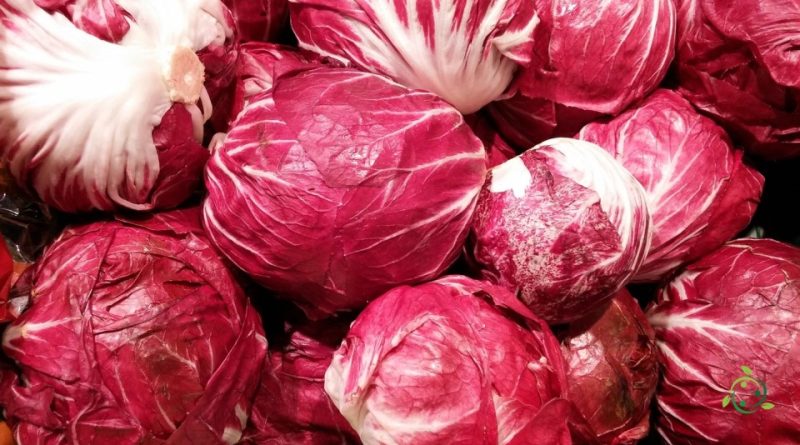Nutritional value of Radicchio
Nutritional value of Radicchio
Radicchio is a perennial cultivated form of leaf chicory (Cichorium intybus L., 1753) that is grown as a leaf vegetable and usually has red colored, white-veined leaves that form a head. Radicchio has a bitter and spicy flavor that sweetens if grilled or roasted.
Characteristics –
Radicchio is a vegetable known for its characteristic bitter flavor and the intense red color of its leaves.
Radicchio is known for its intense red color, although there are varieties with shades of purple, pink or white.
Radicchio leaves are usually arranged in a rosette shape, similar to a head of lettuce, but more compact.
Radicchio has a bitter taste, which varies in intensity depending on the variety and growing conditions. This natural bitterness can be lessened by cooking or combining with other ingredients.
There are different varieties of radicchio, including red radicchio from Chioggia, radicchio from Treviso, radicchio from Verona and others. Each of these varieties has unique characteristics in terms of shape, flavor and use in cooking.
Radicchio is typically an autumn and winter vegetable, with its peak season during the colder months. It can also be grown in a greenhouse or under controlled conditions to obtain fresh radicchio all year round.
Radicchio is a good source of vitamins, minerals and antioxidants. It is particularly rich in vitamin K and vitamin C, as well as containing dietary fiber and health-promoting phytonutrients.
This vegetable can be eaten raw, in salads, or cooked in various preparations. It is often used in Italian dishes, such as risotto, pasta or together with cheeses such as gorgonzola. As mentioned, cooking can help reduce bitterness and make the flavor more delicate.
Radicchio can also be stored in the refrigerator for several days, wrapped in a plastic or aluminum bag, to maintain freshness and crunchiness.
Radicchio is considered a healthy food thanks to its content of antioxidants, vitamins and minerals. It can help support immune system health, digestion and bone health.
Radicchio’s unique flavor can add complexity to dishes and balance sweeter or neutral flavors. It is often used to add a bitter note to contrast with other ingredients.
Nutritional sheet –
The nutritional data sheet of radicchio may vary slightly based on the specific variety and the preparation and cultivation system; Below are the average nutritional values per 100 grams of raw radicchio:
– Calories: approximately 23 kcal
– Protein: approximately 0.8 grams
– Carbohydrates: approximately 4.5 grams
– Sugars: approximately 0.9 grams
– Fibers: approximately 0.9 grams
– Fat: approximately 0.2 grams
– Vitamin A: approximately 1090 micrograms (retinol equivalent)
– Vitamin K: approximately 34.8 micrograms
– Vitamin C: approximately 8.0 milligrams
– Folate: approximately 48 micrograms
– Calcium: approximately 19 milligrams
– Potassium: approximately 302 milligrams
– Iron: approximately 0.7 milligrams
– Magnesium: approximately 10 milligrams
In general, radicchio is known to be a good source of vitamin K and vitamin A, which are important for eye, bone and immune system health. It also contains a significant amount of potassium, which is essential for heart and muscle function.
Property –
Radicchio has several health-promoting properties and can be used in various culinary dishes. Here are some of the main properties of radicchio:
– Rich in antioxidants: Radicchio is a good source of antioxidants, such as vitamin C and flavonoids. Antioxidants help fight free radical damage in the body, helping to reduce the risk of chronic disease.
– Source of fiber: Radicchio is rich in dietary fiber, which is important for digestion and can help maintain a healthy digestive system.
– Low Calorie: Radicchio is a low calorie food, making it an ideal choice for anyone looking to control weight or reduce calorie intake in their diet.
– Rich in vitamins and minerals: Contains vitamins such as vitamin K, vitamin A, vitamin B6 and vitamin E, as well as minerals such as potassium and calcium, which are important for bone health.
– Phytochemicals: Radicchio contains phytochemicals, such as carotenoids and polyphenols, which may have beneficial effects on health and the immune system.
– Promotes Heart Health: The fiber and antioxidants found in radicchio may help reduce the risk of heart disease by helping to lower bad cholesterol in the blood.
– Support for Gut Health: Dietary fiber may play an important role in maintaining a healthy gut microbiota, improving gut health.
– Anti-inflammatory Potential: Some studies suggest that radicchio might have anti-inflammatory properties, which could be helpful in reducing inflammation in the body.
– Blood sugar control: Thanks to its low calorie content and high fiber content, radicchio can help keep blood sugar levels stable.
– Unique Flavor and Culinary Versatility: Radicchio’s slightly bitter flavor makes it an attractive choice for a variety of dishes, such as salads, side dishes, risottos, and even grilled dishes.

